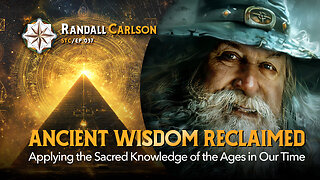Premium Only Content

Weather Engineering and the Forgotten Genius of Wilhelm Reich and Trevor James Constable
Introduction: A Hidden Legacy of Weather Modification
The concept of controlling and counteracting weather manipulation might sound like a premise from science fiction, yet the work of pioneers like Wilhelm Reich and Trevor James Constable suggests otherwise. Their unconventional technologies, rooted in principles of orgone energy, etheric manipulation, and intention-based engineering, offer compelling insights into how humanity might engage with weather systems. As discussions around geoengineering intensify, revisiting their contributions may unlock solutions for countering artificial climate manipulation.
I. Wilhelm Reich’s Cloudbusters: Harnessing Orgone Energy
1. What is Orgone Energy?
Wilhelm Reich, an Austrian psychoanalyst and scientist, introduced the concept of “orgone energy,” a life-force energy akin to chi or prana. According to Reich, this energy permeates the environment and has profound effects on health, weather, and even atmospheric conditions.
2. The Cloudbuster: A Radical Invention
Reich’s cloudbuster is a deceptively simple device made of long, hollow metal pipes grounded in water:
• Mechanism: The pipes supposedly attract orgone energy from the atmosphere, directing it into the water, which serves as a grounding agent.
• Effect: By manipulating atmospheric orgone concentrations, the device could reportedly break up cloud formations, stimulate rainfall, or dissipate storms.
• Historical Success: In the 1950s, Reich claimed to have used the cloudbuster to end droughts in Maine, attracting both support and skepticism.
3. Counteracting Geoengineering
Reich’s work suggests that natural energy manipulation could neutralize the artificial weather-modification technologies used in geoengineering, such as cloud seeding or ionospheric heating.
II. Trevor James Constable: Etheric Weather Engineering
1. Etheric Weather Theory
Trevor James Constable, a researcher and engineer, expanded on Reich’s ideas by integrating etheric energy—a subtle, non-physical force believed to influence physical phenomena. Constable’s methods focused on shaping weather patterns using intentional designs and structures.
2. Practical Applications
Constable’s weather engineering devices did not require water, relying instead on geometrically designed structures, often made of copper and other conductive materials:
• Copper Boards: Simple, portable devices meant to interact with atmospheric energy fields.
• Energy Resonance: Constable believed that focusing intent and utilizing specific geometries could amplify the device’s effects, influencing cloud formations and precipitation.
3. The Flower of Life Experiment
Modern enthusiasts have adapted Constable’s principles, incorporating sacred geometries like the Flower of Life into cloudbusting devices. Reports from Germany claim that such enhancements create intricate patterns in the sky, reflecting the geometrical shapes used on the ground.
III. The Science Behind the Unconventional
1. Resonance and Intention
Reich and Constable’s technologies point to the interplay between human intention, geometric designs, and natural forces:
• Harmonic Resonance: Copper pipes and sacred geometries might interact with Earth’s electromagnetic field, amplifying specific frequencies that influence weather systems.
• Intentional Energy: The idea that focused human intention can alter physical phenomena aligns with emerging research in quantum physics and consciousness studies.
2. Ether as a Medium
Though dismissed by mainstream science, the concept of ether—a subtle energy medium—has historical precedent:
• Nikola Tesla: Tesla’s experiments with wireless energy transmission relied on etheric principles.
• Modern Implications: Revisiting ether theory may provide a framework for understanding how simple devices can influence vast atmospheric systems.
IV. Applications for Countering Geoengineering
1. DIY Cloudbusters
Creating a backyard cloudbuster is remarkably simple:
• Materials: Copper pipes, water, and a grounding base.
• Setup: Insert the pipes into the ground, connect them to a water source, and arrange them in configurations that align with sacred geometries.
• Daily Maintenance: Filling the pipes with water regularly is believed to maintain their effectiveness.
2. Empowering Communities
Reich and Constable’s methods are accessible and scalable, enabling individuals to combat localized effects of weather manipulation:
• Neutralizing Artificial Storms: Reports suggest these devices can dissipate clouds or mitigate storm intensity.
• Reclaiming Autonomy: By engaging with these technologies, communities can regain some control over their environment, countering the dominance of large-scale geoengineering projects.
V. The Implications of Weather Engineering
1. Ethical Questions
While these technologies offer potential benefits, their use raises ethical considerations:
• Unintended Consequences: Altering weather patterns might disrupt ecosystems or neighboring regions.
• Access and Equity: Should these methods become widely adopted, ensuring equitable access and responsible use will be critical.
2. The Potential for Positive Change
Reich and Constable’s work represents a shift toward harmonious interaction with natural systems:
• Sustainable Practices: Their devices rely on minimal resources, contrasting with energy-intensive geoengineering technologies.
• Holistic Understanding: Integrating their principles with modern science could lead to a more balanced approach to environmental stewardship.
Conclusion: Rediscovering Forgotten Solutions
Wilhelm Reich and Trevor James Constable’s pioneering work offers a visionary alternative to the industrialized approach of geoengineering. Their cloudbusters and etheric weather engineering devices remind us of the profound connections between human intention, natural forces, and technological innovation.
As we face escalating climate challenges, these forgotten solutions deserve renewed attention—not only as tools for mitigating artificial weather manipulation but as pathways to deeper understanding and respect for the delicate balance of our planet. Whether through simple backyard experiments or larger-scale applications, the principles they uncovered could hold the key to a more harmonious future.
By revisiting the legacies of these trailblazers, we take a step toward reclaiming our agency in shaping the weather—and the world—around us.
-
 1:32
1:32
FragmentsOfTruth
2 days agoJapan Declares State of Emergency After 96 Million Citizens Found with Nanobots – What Happens Next?
1571 -
 9:10
9:10
ariellescarcella
12 hours agoI Asked People To Toss Out An Identity : The Queer Alphabet Is OVER
5.48K7 -
 27:00
27:00
Squaring The Circle, A Randall Carlson Podcast
19 hours agoSPECIAL EPISODE: #037 Randall Carlson Explains The Vital Role of Sacred Geometry in the Modern Age
6.26K2 -
 58:35
58:35
Trumpet Daily
21 hours ago $6.07 earnedThe Trade War Begins - Trumpet Daily | Feb. 3, 2025
20.6K35 -
 47:03
47:03
Uncommon Sense In Current Times
19 hours ago $0.63 earnedArrested For Praying Silently in Western Culture and Convicted
13K2 -
 44:19
44:19
PMG
17 hours ago $0.54 earnedIn the wake of a tragedy! Finding hope in broken times
8.34K -
 3:40:50
3:40:50
FreshandFit
10 hours agoGirls Walk Off Pod After Being Exposed As Thots By Chat! 🤣
111K123 -
 5:30:06
5:30:06
SpartakusLIVE
14 hours ago#1 King of Content kicks off YOUR week with Monday MOTIVATION
133K8 -
 5:56:52
5:56:52
Akademiks
13 hours agoKendrick Lamar Sweeps Grammys. Drake announces new album on Feb 14. Rocky Trial Might get Dismissed?
106K7 -
 3:25:02
3:25:02
BrancoFXDC
11 hours ago $3.73 earnedWarzone Rebirth Rounds
48.9K